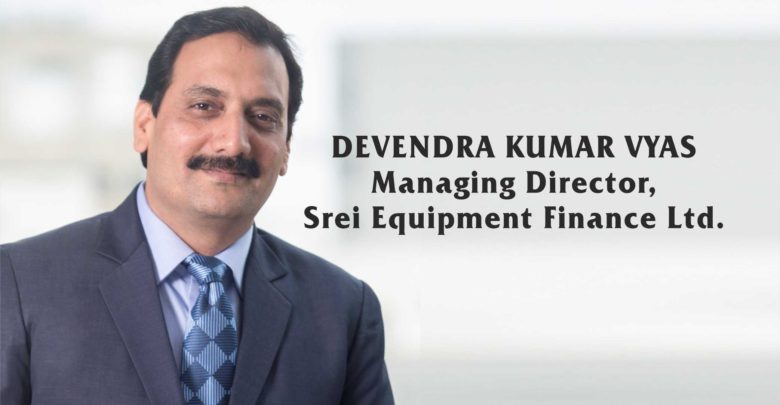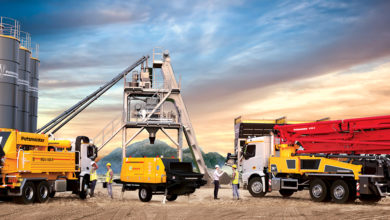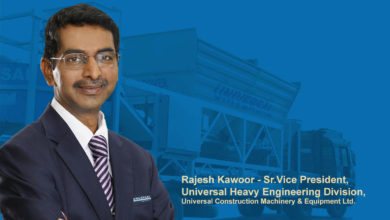MSME REVIVAL – A KEY STRATEGY TO BEATING THE PANDEMIC
DEVENDRA KUMAR VYAS, Managing Director, Srei Equipment Finance Ltd.

The last fiscal year turned out to be a difficult year for the construction equipment sector due to an election induced slowdown in the construction sector, liquidity crisis triggered by the IL&FS crisis, slump in manufacturing and sporadic floods across the country. The current fiscal started with pandemic and colossal economic challenges for the country.
In its effort to provide economic support and stimulus, the government announced a Rs 20-lakh-crore Atmanirbhar package with the hope to bring back some level of normalcy. Most of the stimulus has been directed towards micro, small, and medium enterprises (MSMEs) segment which is the biggest growth driver of the economy, contributing around 30% of the total GDP of the country.
The biggest and the most critical announcement has been the change in the definition of MSME. The definitions of MSME are no more based on the investment alone but also on turnover and the existing distinction between manufacturing and services units has been eliminated.It is heartening to observe that the sheer scale of the definition has been enhanced and probably the only requirement going forward would be to simplify the definition more and make implementation simply digital.
Another crucial incentive for the MSME sector involves collateral-free loan up to the tune of Rs. 3 lakh crore, fully guaranteed by the government, moratorium of 12 months for the principal payment, and a cap on interest rate.This incentive is the most substantive benefit as it will help MSMEs to meet the working capital needs and keep their heads above water even as the economy slows down and at the same time not exposing the banking sector to any risk.
Some other measures include subordinated debt scheme worth Rs 20,000 crores, creation of a fund with a corpus of Rs 50,000 which will help in the revival of stressed MSMEs and in turn help the formal banking system to meet the credit demand of the MSMEs. To help MSMEs further, global tenders will be banned for government procurement up to Rs 200 crore. Indian MSMEs often faced unfair competition from foreign companies and this step will give an impetus to the domestic MSMEs sector in line with the objective of Make in India campaign and Atmanirbhar Bharat Abhiyan.
The stimulus package announced under Atmanirbhar Bharat Abhiyan for the MSME sector and the NBFC sector has a direct impact on the infrastructure sector and consequently the construction equipment sector. This is because most of the construction activities are carried out by the contracting segment and with the change in the definition of MSME, a large chunk of the contractors havenow fallen under the purview of the MSME definitions and are likely to derive benefits from the stimulus package.
While the stimulus package has been a booster for the MSME sector, the multiplier effect on the economy will depend on the length of implementation of the fiscal package. To begin with, the government needs to urgently address the clarity in policy communication by making it simple for the end beneficiary without leaving any room for subjectivity. For instance, to encourage MSMEs to take part in tenders below Rs. 200 crores, global tenders have been disallowed but has bestowed power to the respective departments in ‘exceptional case’ scenarios to consider global tender enquiry. The loan guarantee scheme is another such measure expected to act as a catalyst for lending to this sector, but its success will depend on clear guidelines on implementation to banks and NBFCs, and communication on the steps to leverage this stimulus package for the MSME segment.In the infrastructure sector, contractors still find owning an asset difficult. While MSMEs struggle with liquidity, large contractors too face difficulty in acquiring specialized equipment due to over-leveraged books.
With banks today not in a position to provide long-term loans for the infrastructure sector and India’s corporate bond market not yet matured to a stage where it can be a viable source of long-term funds, the present situation calls for the creation of dedicated vehicles, especially to ensure that infrastructure financing does not come to a standstill.We need to create a Dedicated Financial Institution for Infrastructure (DFII) or Long Term Credit Bank (LTCB) whose role would be to provide medium and long term credit for Greenfield and Brownfield projects in manufacturing and infrastructure. As a specialised institution with expertise in project finance, the DFII should be in a position to evaluate and appraise loan proposals better and mitigate risks. The DFII can also play an important role in developing the dormant corporate bond market in India through credit enhancement and partial credit guarantees. There is a domestic pool of long-term funds like the Pension Funds and Insurance Funds which can be a perfect fit for infrastructure projects. The DFIIs can innovatively tap such fund sources.
Further, the policymakers should come forward and support NBFCs who have been the flag bearers of this cause for a very long time. The policymakers should pay heed to the demand that a one-time restructuring window for smaller customers is needed without affecting the asset classification. For MSME loans, this window exists till December 2020; NBFCs request the government to extend this window to all other borrowers as well.
In a time like this, leasing can play a big role in reviving investments. Across many developed and developing economies globally, leasing of equipment and real assets is a prominent source of private capital formation and contributor to GDP. For some of the developed nations globally, the equipment leasing as a percentage of private capital formation is as high as 40%. In India however, the leasing penetration is abysmally low at less than 3%.Rental service and pay per use models have surfaced as the most trending demand in the sector as it is drastically reducing the cost of undertaking a project. Leasing, a single point solution to tackle the bottlenecks faced by MSMEs and large contractors to acquire construction equipment, which is one of the major cost component of infrastructure projects, is emerging as a new trend in India and is gaining fast momentum.
There is a need for a joint effort from the policy makers as well as industry players to promote leasing in the economy. While industry players need to create a conducive taxation environment for leasing to prosper, industry players should initiate steps to promote leasing by educating small contractors and entrepreneurs of its benefits.Currently, it GST rate is same for rental and purchase of the asset. To incentivise leasing, GST rate on lease rentals should be below the GST rate on actual equipment purchase cost to promote lease as a tool of capital formation. Also, depreciation rate should at least be at par with CV; i.e. 30% against the current rate of 15%.






